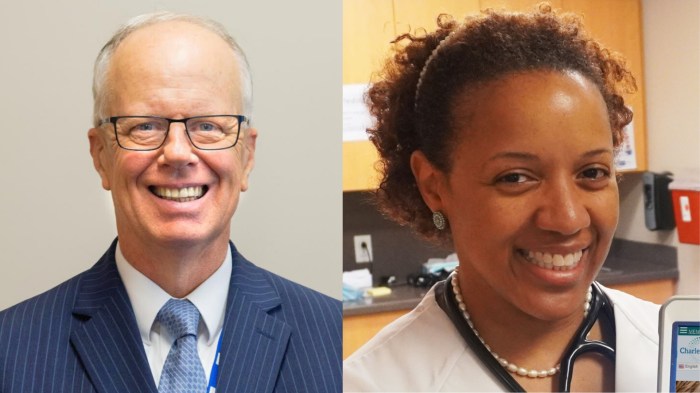Some Long Island hospital executives began their careers as staff nurses, and the experience they gained at the bedside helps inform their decisions as health care leaders.
Amy E. Loeb started out as an oncology nurse, first in an infusion center and then at Huntington Hospital, where she worked the night shift and was subsequently asked to become an assistant night manager. She took on increasingly progressive management positions within the Northwell Health system, culminating in her current role as president of Peconic Bay Medical Center and the PBMC Foundation in Riverhead.
“In oncology, you have a really important role in patients’ lives,” Loeb said. “I recognized that what I was able to do and what our team was able to do on behalf of the patient was so meaningful to the patient, and this recognition has impacted my leadership in terms of patient-centeredness. It has given me a keen awareness that everything we do impacts the patient in the bed and their family, and it’s something that they will never forget.”
Before ascending to senior vice president and system chief nurse executive for Catholic Health, Gara Edelstein held nursing positions within the health system at just about every level, from staff nurse up to chief nursing officer of St. Catherine of Siena Hospital and then Good Samaritan University Hospital.
“I’m now sitting at a table with other executives with different backgrounds, and the most important thing I bring to the table is, I’m the voice of the nurse at the bedside,” Edelstein said. “Patient care is a business, and it’s critical that you have clinical people and nurses in particular at the board table and the leadership table so that you don’t forget what business you’re in: the business of taking care of patients. Every decision I make [is done while] thinking about a nurse at the bedside taking care of a patient.”
Read also: May is Nurses’ Month: bringing compassion and expertise to patients
Northwell Health Senior Vice President Kerri Scanlon, who serves as president of Glen Cove, Syosset and Plainview hospitals, said that Northwell Health CEO Michael Dowling has long believed in the importance of elevating nurses to leadership roles, since they have an excellent handle on nursing operations, which she said accounts for 65% of total operations.
“My nursing background allows me to really understand what we’re doing to provide the best patient care and to understand what we have today versus what we need to be putting in place tomorrow to provide that care,” said Scanlon, who has taken on positions of increasing responsibility since joining Northwell early in her career as a cardiothoracic intensive care nurse at North Shore University Hospital.
Carolyn Santora, chief nursing officer and chief of regulatory affairs at Stony Brook University Hospital, began her nursing career in surgical oncology at St. Vincent’s Hospital before joining the surgical unit at Stony Brook University Hospital when it opened in 1979.
“My background in giving care allows me to understand the clinical implications of the choices I make,” Santora said. “That knowledge helps me make my decisions and helps inform the standards I put in place.”
Lauren Stoerger, who spent the first eight years of her career working as a staff nurse in critical care at Weill Cornell Medical Center, recently joined NYU Langone Hospital-Long Island as vice president of nursing and patient care services.
“My background in nursing allows me to ensure our delivery of care is exceeding our standards,” she said. “We’re always working on ways to improve and continually raise the bar, and the time I spent at the bedside allows me to understand the challenges nurses face and provide more support for them in order to provide better care for patients.”
Stoerger adds, “I loved taking care of patients as a bedside nurse, and as I was able to move up to progressive leadership roles, I was able to care for more patients, by creating structures and providing support to allow improved care delivery.”
But although they are now able to impact patients on a grander scale, these professionals miss the direct relationships they were able to form with patients as bedside nurses.
“The most gratifying and memorable experiences I have had are those interactions with patients,” Santora said. “There’s nothing more satisfying than working with a patient and their family, seeing a positive outcome and discharging a patient who is getting better, or supporting them through difficult times or end-of-life care.”
Scanlon said, “The best of nursing is seeing the direct impact you have on a patient and the patient’s family. When they say thank you for that incredible impact, I can’t tell you what it does for you as a person.”
“When I was able to take a few minutes and sit with a patient, I heard a lot of personal stories, and I miss those conversations,” Loeb said. “It was a privilege to hear their stories and minimize their suffering and help people transition back home.”
But there are things they don’t miss.
“I don’t miss the stress of competing priorities at the bedside,” Santora said. “If you care for a group of patients, and one patient is in pain, you have to give them comfort, but you may need to prepare another patient for a procedure at the same time. You never quite feel like you have done enough for all your patients.”
For her first year or so as a nurse, Loeb remembers lying in bed at night, thinking about whether she had made any mistakes or forgotten to do something. Scanlon recalls having vivid dreams about things such as whether she had given a patient the right medication. “Having the care of another person’s life in your hands is an unbelievable responsibility,” she said.
Edelstein said she doesn’t miss the “physically challenging” aspect of bedside nursing. “But nursing is a wonderful, wonderful profession, and I wouldn’t trade it for the world,” she said.



































